Yves GARY Hits: 10884
Category: OWNERS
 John Pierpont "J.P." Morgan (April 17, 1837 – March 31, 1913) was an American financier and banker who dominated corporate finance and industrial consolidation during his time.
John Pierpont "J.P." Morgan (April 17, 1837 – March 31, 1913) was an American financier and banker who dominated corporate finance and industrial consolidation during his time.
Morgan was born into the influential Morgan family to Junius Spencer Morgan (1813–1890) and Juliet Pierpont (1816–1884) in Hartford, Connecticut, and was raised there.
Pierpont, as he preferred to be known, had a varied education due in part to the plans of his father. In the fall of 1848, Pierpont transferred to the Hartford Public School and then to the Episcopal Academy in Cheshire,  Connecticut (now called Cheshire Academy), boarding with the principal. In September 1851, Morgan passed the entrance exam for the English High School of Boston, a school specializing in mathematics to prepare young men for careers in commerce. In the spring of 1852, an illness struck which was to become more common as his life progressed. Rheumatic fever left him in so much pain that he could not walk, and Junius sent him to the Azores to recover.
Connecticut (now called Cheshire Academy), boarding with the principal. In September 1851, Morgan passed the entrance exam for the English High School of Boston, a school specializing in mathematics to prepare young men for careers in commerce. In the spring of 1852, an illness struck which was to become more common as his life progressed. Rheumatic fever left him in so much pain that he could not walk, and Junius sent him to the Azores to recover.
He convalesced there for almost a year, then returned to the English High School in Boston to resume his studies. After he graduated, his father sent him to Bellerive, a school near the Swiss village of Vevey, where he gained fluency in French. His father then sent him to the University of Göttingen in order to improve his German. He attained a passable level of German within six months and also a degree in art history, then traveled back to London via Wiesbaden, with his education complete.
After working for his father, he started his own private banking company in 1871, which later became known as J.P. Morgan & Co. His company became one of the leading financial firms in the country. It was so powerful that even the U.S. government looked to the firm for help with the depression of 1895. The company also assisted in thwarting the 1907 financial crisis.
He was an ardent art collector, creating one of the most significant collections of his time. He later donated his art collection to the Metropolitan Museum of Art, and his collection of written works to the Morgan Library—both in New York City.
Morgan's summer routine was to spend weekends with his family on his estate at Cragston on the Hudson River, and on Sunday nights to steam back to Manhattan on Corsair. 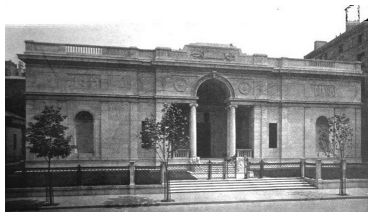 He had learned to pace himself and enjoy a regular long annual vacation. "I can do twelve months work in nine months," he would say. "But not in twelve months."
He had learned to pace himself and enjoy a regular long annual vacation. "I can do twelve months work in nine months," he would say. "But not in twelve months."
Morgan's first marriage to Amelia Sturges was brief. She died a few months after their 1860 wedding. Five years later, Morgan married Frances Tracy. The couple had four children: John Pierpont Jr., Louisa, Juliet and Anne.
Morgan died in Rome, Italy, in his sleep on March 31, 1913 at the age of 75, leaving his fortune and business to his son, John Pierpont Morgan, Jr. On April 14, the day of his funeral, the New York Stock Exchange closed in his honor until noon. He was buried in the Morgan family mausoleum at a Hartford cemetery.

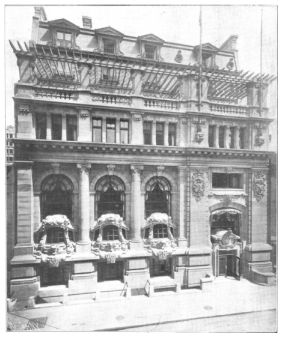 He was the godfather of the modern New York Yacht Club and, therefore, of modern elite yachting. He joined in 1882, and 15 years later was elected commodore, having never served the club in any other capacity. As soon as the challenge of Sir Thomas Lipton has been accepted, J. Pierpont Morgan and Edwin Dennison Morgan of New York Yacht Club ordered promptly to Herreshoff for a cup-defence vessel, to be known as Columbia. Columbia beat Shamrock on October 1899, three wins to nil, and was selected again in 1901 to defend the Cup, and again under the command of Charlie Barr, won all three races against Shamrock II. She was the first vessel to win the trophy twice in a row (a record not equaled until Intrepid's back-to-back wins in 1967 and 1970).
He was the godfather of the modern New York Yacht Club and, therefore, of modern elite yachting. He joined in 1882, and 15 years later was elected commodore, having never served the club in any other capacity. As soon as the challenge of Sir Thomas Lipton has been accepted, J. Pierpont Morgan and Edwin Dennison Morgan of New York Yacht Club ordered promptly to Herreshoff for a cup-defence vessel, to be known as Columbia. Columbia beat Shamrock on October 1899, three wins to nil, and was selected again in 1901 to defend the Cup, and again under the command of Charlie Barr, won all three races against Shamrock II. She was the first vessel to win the trophy twice in a row (a record not equaled until Intrepid's back-to-back wins in 1967 and 1970).
Morgan's most lasting service to N.Y.Y.C. was to buy the plots of land on which the present clubhouse was built. In Morgan fashion, he made two stipulations: It must be a big building whose design was selected by a committee of one, himself, and its increased cost of management must be covered by doubling the annual dues from $25 to $50. The Warren & Wetmore-designed building on West 44th Street was opened in 1901. To this day, Morgan's personality is pervasive there. His official commodore's portrait growers from a stairwell wall near the Model Room, which is dominated by huge models of the second Corsair -- as yacht and warship -- and of the models of the great Cup defenders he sponsored a century ago.
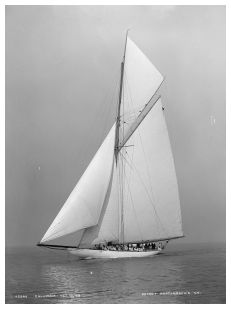 In 1881, Morgan placed an option to buy a 185' black-hulled steam yacht called Corsair. He was an intensely private man even before he became a celebrity, and as he aged, he found privacy more and more frequently on his yachts. By the end of the decade, he built a new 241' vessel to the design of J. Beavor-Webb. Morgan used the Corsair II well and hard. She was not the largest NYYC yacht. Four other members’ yachts exceeded 300 feet, including W. K. Vanderbilt’s 332-foot Valiant. It was on this Corsair that, as commodore, he led the NYYC fleet to Maine in 1897 - the club's first Annual Cruise to Maine.
In 1881, Morgan placed an option to buy a 185' black-hulled steam yacht called Corsair. He was an intensely private man even before he became a celebrity, and as he aged, he found privacy more and more frequently on his yachts. By the end of the decade, he built a new 241' vessel to the design of J. Beavor-Webb. Morgan used the Corsair II well and hard. She was not the largest NYYC yacht. Four other members’ yachts exceeded 300 feet, including W. K. Vanderbilt’s 332-foot Valiant. It was on this Corsair that, as commodore, he led the NYYC fleet to Maine in 1897 - the club's first Annual Cruise to Maine.
When in 1898, the government requested that he hand Corsair II over for naval duty in the war against Spain, Morgan impatiently ordered a new 304' Corsair. Designed by John Beavor-Webb, Corsair III was built in 1898 by T. S. Marvel Shipbuilding, Newburgh, New York, and her hull launched in December 1898. On 2 January 1930, the Coast and Geodetic Survey acquired Corsair III as a donation from J. P. Morgan, Jr. with the stipulation the ship be used as a Coast and Geodetic Survey work.
A yachtsman, like his father, J. P. Morgan, Jr. served as commodore of the New York Yacht Club from 1919 to 1921. In 1930 he built the turbo electric driven yacht Corsair IV at Bath Iron Works. Corsair IV, launched April 10, 1930, was one of the most opulent yachts of its day and the largest built in the United States with an overall length of 343 feet (104.5 m), 42 feet (12.8 m) beam and 2,142 GRT. Morgan sold the Corsair IV to the British Admiralty in 1940 for one dollar to assist with Britain's war effort.
 |
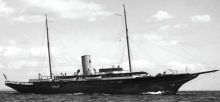 |
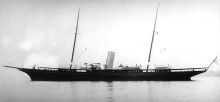 |
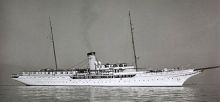 |
| CORSAIR | CORSAIR II | CORSAIR III | CORSAIR IV |

J. P. Morgan - Wikipedia, the free encyclopedia
- J P Morgan - HISTORY
- Commodore J. Pierpont Morgan - New York Yacht Club
- America’s Cup Legend: J. Pierpont Morgan - Nob Hill Gazette
- J.P. Morgan Acrylic Prints and Art for Sale - FineArtAmerica.com
- USS Gloucester (1891) Corsair II - Wikipedia, the free encyclopedia
- USS Oceanographer (AGS-3) Corsair III - Wikipedia, the free encyclopedia
- USN Ships--USS Corsair (SP-159), later USS Oceanographer (AGS-3) - Online Library of Selected Images
- SS Corsair IV - ssMaritime
